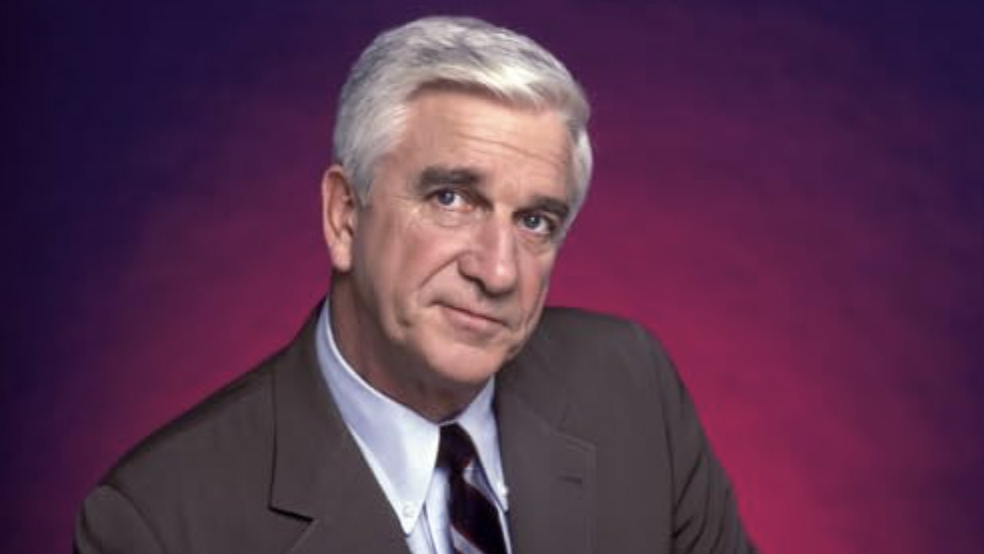
Why Leslie Nielsen Became Comedy’s Greatest Second Act
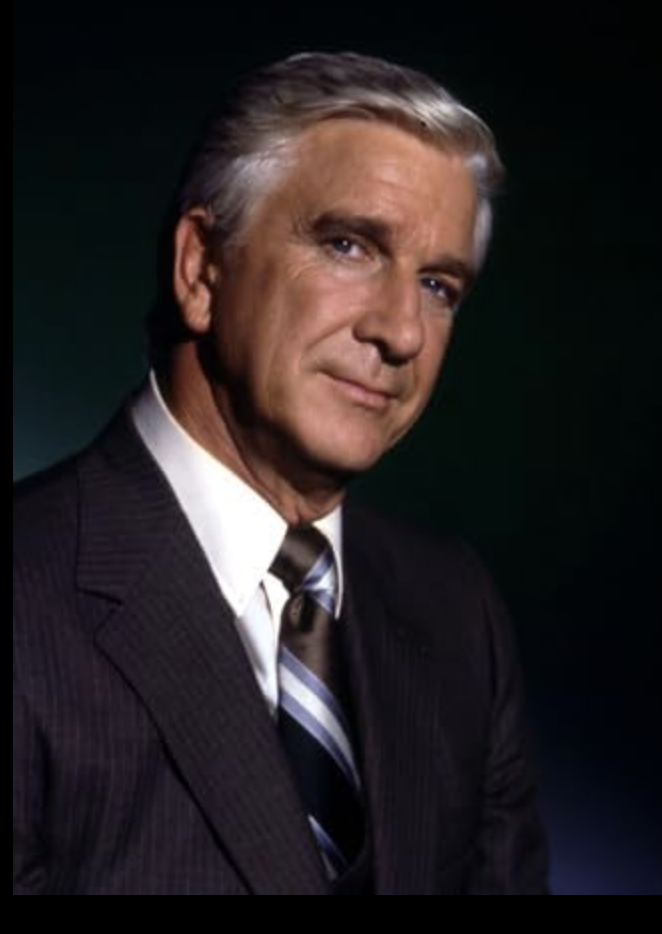
Leslie Nielsen transformed from a forgotten dramatic actor into one of Hollywood’s most beloved comedy legends, proving that reinvention can happen at any stage of a career. Born in Regina, Saskatchewan on February 11, 1926, Nielsen spent nearly three decades playing serious roles before finding his true calling in parody films.
Quick Facts About Leslie Nielsen:
- Born: February 11, 1926 in Regina, Saskatchewan, Canada
- Died: November 28, 2010 (age 84) from pneumonia complications
- Career Span: 60 years, appearing in over 100 films and 150 TV programs
- Famous For: Airplane! (1980) and The Naked Gun series (1988-1994)
- Signature Style: Deadpan delivery in absurd situations
- Awards: Officer of the Order of Canada, Hollywood Walk of Fame star
Nielsen’s career pivot came at age 54 when he starred as Dr. Rumack in Airplane!, delivering the now-iconic line “I am serious… and don’t call me Shirley.” This role launched his second act as what critic Roger Ebert called “the Olivier of spoofs.”
His journey from the Canadian prairies to becoming a comedy icon resonates particularly well here in New York City, where Nielsen honed his craft at the prestigious Neighborhood Playhouse and appeared in countless live television productions during the medium’s golden age. The city’s entertainment industry provided the foundation for what would become one of the most remarkable career changes in Hollywood history.
As R. Couri Hay, having covered New York’s entertainment scene for over four decades, I’ve witnessed many career reinventions, but few match the complete change of Leslie Nielsen from forgettable leading man to comedy legend. His story offers valuable insights into the unpredictable nature of show business success.
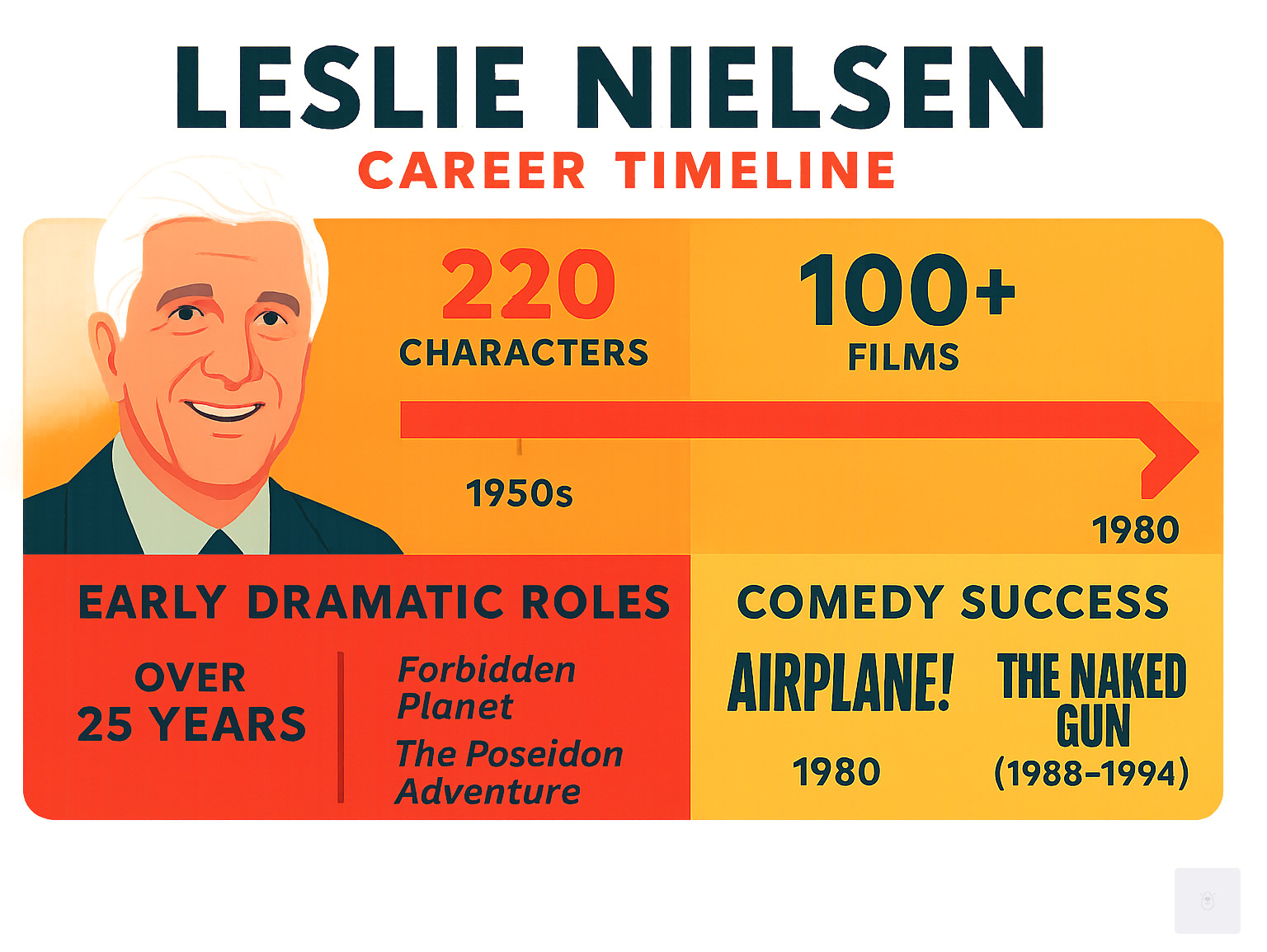
Explore more about leslie nielsen:
From the Canadian Prairies to New York City’s Stage
Long before Leslie Nielsen became the master of deadpan comedy, his journey began in the windswept prairies of Western Canada. Born in Regina, Saskatchewan on February 11, 1926, young Leslie William Nielsen would travel an unlikely path from the Canadian wilderness to the bright stages of New York City.

Early Life and Influences
Leslie Nielsen’s childhood was far from glamorous. Growing up in the remote town of Tulita (then called Fort Norman) in the Northwest Territories, he lived under the shadow of his father, Ingvard Nielsen, a strict and often harsh Royal Canadian Mounted Police constable. The family atmosphere was tense, with his father’s authoritarian nature creating a difficult home environment.
His mother, Mabel Elizabeth, brought Welsh heritage to the family, while his brother Erik Nielsen would eventually rise to become Canada’s Deputy Prime Minister. But perhaps the most significant early influence came from his uncle, Jean Hersholt, a successful actor who appeared in over 140 films and starred in a popular radio series.
At 17, seeking escape and purpose, Leslie Nielsen enlisted in the Royal Canadian Air Force during World War II, training as an aerial gunner. What many didn’t know was that he suffered from significant hearing loss throughout his life, wearing hearing aids that he cleverly concealed from public view. This condition never held him back from his military service or his future career.
After the war, Nielsen briefly worked as a disc jockey at a radio station in Alberta, his first real taste of performance work. But the entertainment bug had truly bitten him, thanks in large part to his uncle’s influence and his own growing confidence behind the microphone.
Forging a Career in New York
The young Canadian’s next move would prove pivotal. Leslie Nielsen enrolled at the Lorne Greene Academy of Radio Arts in Toronto, where his natural talent earned him something extraordinary: a scholarship to study at the prestigious Neighborhood Playhouse School of the Theatre in New York City.
Under the guidance of legendary acting teacher Sanford Meisner, Nielsen learned the craft that would serve him throughout his career. The Meisner technique emphasized truthful, emotional acting – skills that would later make his comedic performances so effective because they felt completely genuine.
Nielsen often described feeling like a “hayseed from Canada” during those early New York days, surrounded by sophisticated actors and fearing he’d be exposed as a fraud. But his dedication and natural presence quickly proved those fears unfounded.
His television debut came in 1948 on Studio One, appearing alongside Charlton Heston for the modest fee of $75. This marked the beginning of an incredible period of productivity during Television’s Golden Age. In 1950 alone, Leslie Nielsen appeared in an astounding 46 live television programs, working tirelessly to establish himself in the competitive New York entertainment scene.
Those intense years of live television work proved invaluable training. The medium demanded quick thinking, adaptability, and absolute professionalism – there were no second takes. Nielsen developed his commanding, authoritative screen presence during this period, creating the perfect foundation for what would later become his signature comedic style.
New York City’s thriving television industry of the 1950s provided the ideal launching pad for Nielsen’s career, connecting him with the networks, directors, and fellow actors who would help shape his path to Hollywood stardom.
The Serious Leading Man: Nielsen’s Dramatic Decades
For nearly three decades, Leslie Nielsen was the quintessential straight man—literally. Long before audiences knew him as the bumbling Frank Drebin, he was the reliable leading man who could deliver authority with that distinctive voice and commanding presence. It’s almost impossible to imagine now, but Nielsen spent most of his career being completely serious on screen.
Sci-Fi Icon and TV Staple
In 1956, Leslie Nielsen landed the role that would define his early career: Commander J.J. Adams in the groundbreaking science fiction film Forbidden Planet. Playing opposite Anne Francis and the iconic Robby the Robot, Nielsen embodied the square-jawed space captain with perfect earnestness. He later joked that the role simply required him to “wear a tight uniform and look at Anne Francis”—but the film became a sci-fi classic that influenced everything from Star Trek to 2001: A Space Odyssey.
This success led to steady work in disaster films, where his authoritative presence made him perfect for roles like the ship’s captain in The Poseidon Trip (1972). Leslie Nielsen also became a familiar face in horror, appearing in Stephen King’s Creepshow (1982) as the vengeful Richard Vickers.
Television was where Nielsen truly made his living during these years. He appeared in over 1,500 television episodes, playing more than 220 different characters. From guest spots on MASH* and Columbo to recurring roles on The Virginian and Hawaii Five-O, he was everywhere. Here in New York City, where television was king during the medium’s golden age, Nielsen’s versatility made him a go-to actor for producers who needed someone dependable and professional.
Critical Reception of Early Work
Despite his prolific output, Leslie Nielsen struggled to stand out in a crowded field of handsome leading men. Critics often described him as reliable but unremarkable—one reviewer dubbed him “Mr. Nondescript.” While he could carry a film and delivered solid performances, he lacked that special something that separates stars from working actors.
Nielsen himself later admitted that his entire early career felt like being “cast against type.” Deep down, he sensed his true calling lay elsewhere, but nobody—including Nielsen—could have predicted where that path would lead.
Notable Dramatic Roles Before Comedy:
Forbidden Planet (1956) as Commander J.J. Adams • The Poseidon Trip (1972) as Captain Harrison • Creepshow (1982) as Richard Vickers • The Plainsman (1966) as Colonel George Armstrong Custer • Beau Geste (1966) as Lieutenant De Ruse • City on Fire (1979) as Mayor William Dudley
Looking back, those decades of playing it straight were the perfect preparation for what came next. Leslie Nielsen had mastered the art of authority and sincerity—qualities that would become hilariously subverted when he finally found his comedic voice at age 54.
The Unlikely King of Spoof: How Leslie Nielsen Redefined Comedy
The year 1980 marked the most significant turning point in Leslie Nielsen’s long and storied career. After decades of playing serious, often stoic characters, he was cast in a role that would irrevocably alter his public image and establish him as a comedic icon.
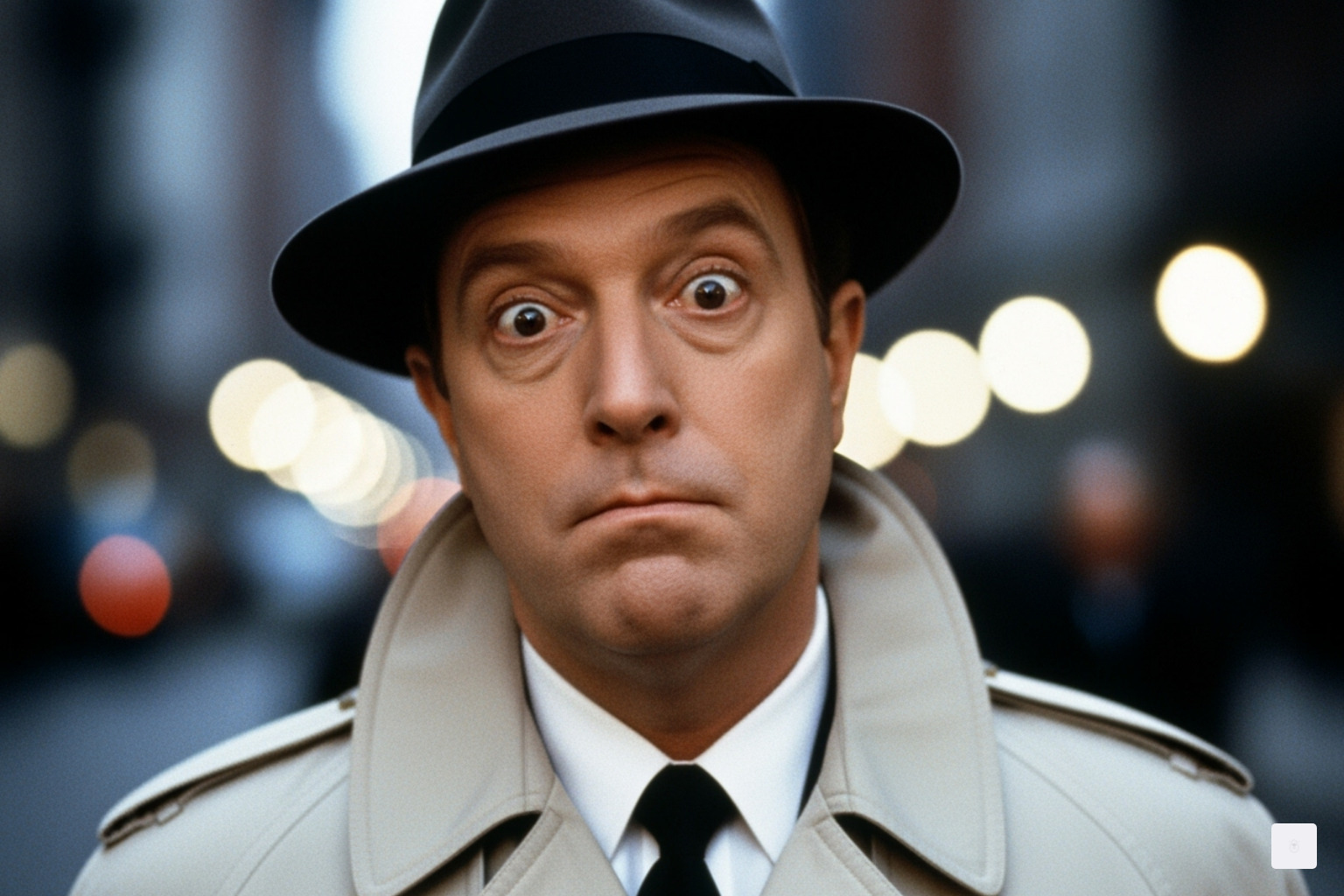
The brilliant filmmaking trio of Jerry Zucker, Jim Abrahams, and David Zucker had a vision for their disaster movie parody Airplane!. Instead of casting traditional comedians, they sought actors known for their unshakable seriousness, placing them in utterly absurd situations. The genius lay in their deadpan delivery heightening the comedic effect.
Leslie Nielsen was their perfect choice. His authoritative persona from decades of dramatic roles made him an ideal straight man for their anarchic comedy. When Dr. Rumack delivered the now-legendary line “I am serious, and don’t call me Shirley,” Nielsen’s stone-faced performance created comedy gold.
The film became a massive success, earning a 97% rating and marking Nielsen’s highest-rated movie. Suddenly, at age 54, the forgotten dramatic actor had found his true calling. The response was so overwhelming that it opened the floodgates for his remarkable second act in comedy.
The ZAZ team quickly reunited with Leslie Nielsen for the television series Police Squad! in 1982. He starred as the bumbling detective Frank Drebin, a character who would become his most beloved creation. The show’s rapid-fire gags and deadpan absurdity were ahead of their time, though it was inexplicably canceled after only six episodes.
Despite its brief run, Police Squad! gained a devoted cult following. Nielsen even received an Emmy Award nomination for his contributions to the short-lived series. More importantly, the character of Frank Drebin was too good to waste.
The undeniable comedic potential couldn’t be contained. Frank Drebin was resurrected for The Naked Gun: From the Files of Police Squad! in 1988, which became a box office smash. This spawned two equally popular sequels: The Naked Gun 2½: The Smell of Fear in 1991 and Naked Gun 33⅓: The Final Insult in 1994. These films solidified Leslie Nielsen’s place as the undisputed king of parody films.
The Art of the Straight Face: Analyzing the Comedic Genius of Leslie Nielsen
What made Leslie Nielsen’s comedic style so devastatingly effective? It was his unparalleled mastery of deadpan delivery. He rarely broke character, maintaining a serious, authoritative, almost oblivious demeanor amidst the most outrageous sight gags and slapstick comedy.
Roger Ebert famously described him as “the Olivier of spoofs,” and the comparison was apt. Nielsen wasn’t trying to be funny in the traditional sense. He was the straight man in a world gone mad, making the absurdity around him exponentially funnier.
His characters, particularly Frank Drebin, were brilliantly empty-headed. They seemed completely unaware of the chaos they caused or the ridiculousness of their own actions. This unique approach resonated with audiences of all ages for over two decades.
Leslie Nielsen himself often countered suggestions that comedy was casting him against type. He believed his first 30 years of dramatic roles were actually against type, insisting he was a closet comedian all along. Having covered New York’s entertainment scene for decades, I can attest that many actors harbor secret comedic ambitions, but few possess Nielsen’s natural gift for it.
His comedic timing was impeccable. He delivered sophomoric punchlines with the gravitas of a Shakespearean actor. This contrast was the key to his timeless success. He didn’t just tell jokes; he embodied the joke by being the perfectly serious, yet completely clueless, individual in a world of lunacy.
We can learn more about the genesis of this comedic turning point by delving into An oral history of Airplane!.
Later Comedies and Parodies Starring Leslie Nielsen
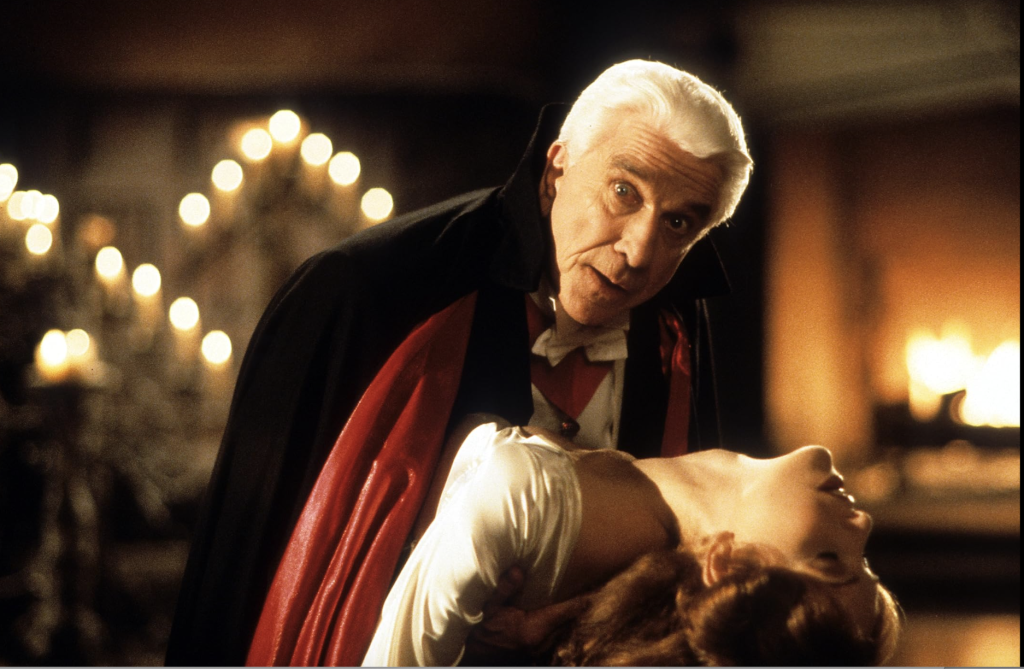
After the phenomenal success of The Naked Gun series, Leslie Nielsen continued starring in parody and spoof films throughout the 1990s and 2000s. While none reached the critical heights of Airplane! or The Naked Gun, they further cemented his status as a comedic legend.
His later endeavors included Spy Hard in 1996, which unfortunately earned only a 7% rating, making it his lowest-rated movie. He also appeared in Wrongfully Accused in 1998, Dracula: Dead and Loving It in 1995, and Mr. Magoo in 1997. His final major film appearances came with Scary Movie 3 in 2003 and Scary Movie 4 in 2006.
Critics often panned these later films, frequently recommending viewers stick to his earlier, more iconic works. The magic of those initial collaborations with the ZAZ team proved difficult to recapture. Yet even in these less successful ventures, Nielsen’s commitment to his deadpan persona remained unwavering.
His dedication was a testament to his unique comedic talent and professional integrity. Leslie Nielsen understood that his gift lay not in chasing laughs, but in maintaining that perfect straight face while chaos erupted around him. It’s a lesson many performers could learn from, particularly here in New York City where the temptation to oversell a joke runs high in our competitive entertainment landscape.
Personal Life, Accolades, and Lasting Legacy
Behind the deadpan delivery and perfectly timed pratfalls, Leslie Nielsen was a man who lived life with the same mischievous spirit that made his comedy so memorable. His personal story reveals someone who never quite grew up – and thank goodness for that.

Leslie Nielsen was married four times throughout his life, finding love repeatedly despite the challenges that come with a Hollywood career. He had two daughters, Thea and Maura, from his marriage to Alisande Ullman. Family remained important to him, even as his brother Erik Nielsen chose a completely different path, eventually becoming Canada’s Deputy Prime Minister. The Nielsen brothers certainly proved that talent runs in the family, just in very different directions.
What truly set Nielsen apart from other actors was his legendary love of practical jokes. He was rarely seen without his portable fart machine, which he wielded with the same precision he brought to his comedic timing. Interviewers, co-stars, and unsuspecting bystanders all fell victim to his perfectly deployed sound effects, delivered with that signature straight face that made it impossible to tell if he was the culprit.
This playful spirit followed him right to the end. When Leslie Nielsen passed away on November 28, 2010, at age 84 in Fort Lauderdale, Florida, from pneumonia complications, he made sure his final act was memorable. His epitaph reads simply “Let ‘er rip” – a perfect goodbye from comedy’s most unlikely king. His funeral was billed as “Cocktails With Leslie and Barbaree,” complete with an open casket, a strategically placed whoopee cushion, and tissues inscribed with “Stop Crying!!!! This is supposed to be a fun night. Love & Laughs Leslie.”
Awards and Recognition
The entertainment industry didn’t overlook Leslie Nielsen’s remarkable contributions. Canada honored him as an Officer of the Order of Canada in 2002, recognizing how this prairie boy had become one of their greatest cultural ambassadors. His Hollywood Walk of Fame star at 6541 Hollywood Boulevard ensures that tourists can literally walk over his legacy for generations to come.
Canada’s Walk of Fame inducted him in 2000, while his television work earned him two Emmy nominations, including recognition for the brilliant but short-lived Police Squad! He received the UCLA Jack Benny Award for comedy, a fitting tribute considering how both men mastered the art of perfect timing. Even Grant MacEwan College named their communications school after him, proving that his influence extended far beyond entertainment.
An Enduring Impact on Film and Comedy
From those early days studying under Sanford Meisner at the Neighborhood Playhouse here in New York City, Leslie Nielsen traveled an extraordinary path. He played over 220 characters across more than 100 films and 150 television programs – a staggering output that speaks to both his work ethic and his versatility.
What makes his legacy so unique isn’t just the quantity of his work, but the way he completely redefined what comedy could be. Nielsen proved that the funniest person in the room might be the one who never cracks a smile. His influence on parody films created a template that countless comedians still follow today. The secret wasn’t in trying to be funny – it was in being absolutely, completely serious while the world went crazy around you.
Here in New York City, where Nielsen first learned to command a stage and camera, his approach to comedy continues to inspire performers in everything from sketch shows to improv theaters. The city’s comedy scene still values that precious ability to play it straight, a skill Nielsen mastered during those intense years of live television in the 1950s.
Leslie Nielsen’s career change from forgotten dramatic actor to beloved comedy icon remains one of Hollywood’s most remarkable second acts. As we’ve witnessed in New York’s entertainment circles, true talent has a way of finding its perfect outlet, even if it takes a few decades. Nielsen’s legacy reminds us that it’s never too late to find what you were really meant to do – and that sometimes, the best way to make people laugh is to never let them see you smile.
Frequently Asked Questions about Leslie Nielsen
Having covered New York’s entertainment scene for decades, I frequently encounter questions about Leslie Nielsen and his remarkable career change. Here are the most common inquiries about this beloved comedy legend.
What was Leslie Nielsen’s most famous movie?
Without question, Leslie Nielsen’s most famous work centers around two iconic franchises: Airplane! (1980) and The Naked Gun series. These films represent the pinnacle of his comedic genius and cultural impact.
Airplane! launched Nielsen’s second career at age 54. His portrayal of Dr. Rumack introduced audiences to his deadpan delivery style, earning the film a remarkable 97% rating on review aggregators. The movie’s success was so profound that it fundamentally changed how Hollywood viewed Nielsen as a performer.
The Naked Gun trilogy, featuring his unforgettable Lieutenant Frank Drebin, became his signature role. Starting with The Naked Gun: From the Files of Police Squad! in 1988, followed by two equally successful sequels, these films showcased Nielsen’s ability to maintain perfect comedic timing while appearing completely oblivious to the chaos around him.
Both franchises had enormous cultural impact, with quotes and scenes still referenced today. They transformed Leslie Nielsen from a reliable dramatic actor into one of comedy’s most recognizable faces.
How did Leslie Nielsen transition from drama to comedy?
Leslie Nielsen’s dramatic career shift remains one of Hollywood’s most fascinating success stories. After nearly three decades playing serious roles in films like Forbidden Planet and countless television appearances, his comedy breakthrough came through an unexpected source.
The Zucker, Abrahams, and Zucker filmmaking team had a vision for Airplane!. Instead of hiring established comedians, they specifically sought dramatic actors with authoritative screen presence. They believed that casting serious performers in absurd situations would amplify the humor through contrast.
Nielsen’s decades of playing military officers, doctors, and stern professionals made him perfect for this approach. His natural gravitas and commanding presence became the ideal foundation for deadpan comedy. When he delivered ridiculous lines with complete sincerity, the effect was hilarious.
This casting strategy proved brilliant. Leslie Nielsen later reflected that his entire early career had been “cast against type,” suggesting his comedic instincts were always present beneath his dramatic roles. The transition allowed him to finally express his true comedic nature.
What is the story behind the line “Surely you can’t be serious?”
The exchange “Surely you can’t be serious?” followed by Leslie Nielsen’s response “I am serious… and don’t call me Shirley” represents one of cinema’s most beloved comedic moments from Airplane!
In the scene, Dr. Rumack (Nielsen) speaks with Ted Striker (Robert Hays) about landing the troubled aircraft. When Striker expresses disbelief, Nielsen delivers his now-legendary retort with perfect deadpan timing. The humor comes entirely from his authoritative delivery of an absurd statement, making the ridiculous sound completely reasonable.
This line perfectly captures Nielsen’s comedic genius – his ability to maintain complete seriousness while saying something utterly silly. The American Film Institute recognized this exchange in their “AFI’s 100 Years…100 Movie Quotes,” cementing its place in film history.
The quote became a cultural touchstone, referenced countless times in other media and conversation. It exemplifies how Leslie Nielsen could transform simple dialogue into unforgettable comedy gold through his unique delivery style.
From our perspective here in New York City, where Nielsen first developed his craft at the Neighborhood Playhouse, it’s remarkable to see how his early dramatic training ultimately served his comedic breakthrough so perfectly.
Conclusion
What a remarkable journey Leslie Nielsen took us on – from the serious, square-jawed leading man of the 1950s to the bumbling, loveable Frank Drebin who made us laugh until our sides hurt. His story proves that sometimes the best things in life come when we least expect them.
Nielsen’s change into comedy’s most unlikely king wasn’t just a career change – it was a complete reinvention that happened at an age when most actors would be winding down. At 54, when he first uttered “Don’t call me Shirley,” he finded his true calling and gave the world decades of pure joy.
His mastery of deadpan delivery created a whole new way of being funny. While other comedians relied on wild expressions or over-the-top antics, Leslie Nielsen proved that sometimes the funniest thing you can do is play it completely straight. He turned being serious into an art form of comedy.
From his early training here in New York City at the Neighborhood Playhouse to his final bow as a beloved icon, Nielsen’s career spanned an incredible 60 years. He appeared in over 100 films and 150 TV shows, bringing laughter to multiple generations. That’s a legacy few entertainers can match.
As someone who’s covered New York’s entertainment scene for decades, I’ve seen many actors try to reinvent themselves. Few succeed as brilliantly as Leslie Nielsen did. His story reminds us that it’s never too late to find who we really are – and that sometimes our greatest strengths are hiding in plain sight.
Even his final goodbye was perfectly Nielsen – that whoopee cushion at his funeral and his “Let ‘er rip” epitaph showed he never lost his playful spirit. He lived as he performed: with perfect timing, endless charm, and always ready to make someone smile.
Leslie Nielsen didn’t just entertain us – he taught us that laughter really is the best medicine, and that taking yourself too seriously might be the most serious mistake of all.
Learn more about our publicity services

